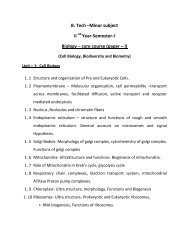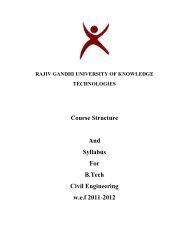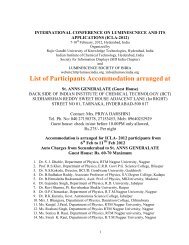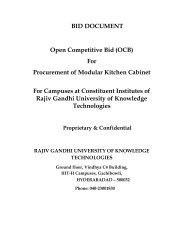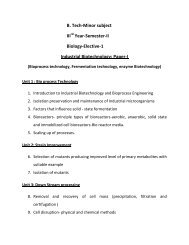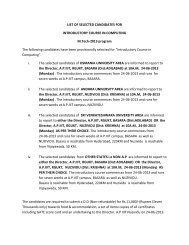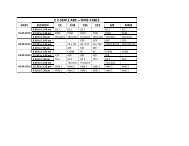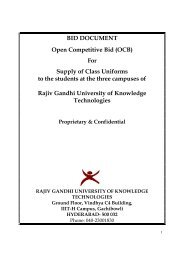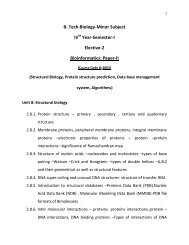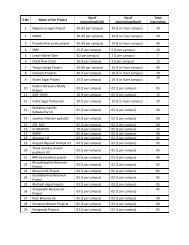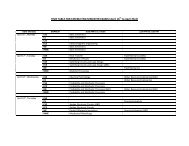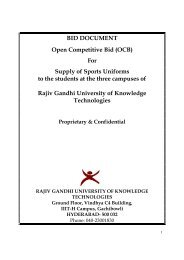B. Tech-Minor Subject III Year-Semester-II Biology-Elective-2 ... - rgukt
B. Tech-Minor Subject III Year-Semester-II Biology-Elective-2 ... - rgukt
B. Tech-Minor Subject III Year-Semester-II Biology-Elective-2 ... - rgukt
Create successful ePaper yourself
Turn your PDF publications into a flip-book with our unique Google optimized e-Paper software.
B. <strong>Tech</strong>-<strong>Minor</strong> <strong>Subject</strong><strong><strong>II</strong>I</strong> rd <strong>Year</strong>-<strong>Semester</strong>-<strong>II</strong><strong>Biology</strong>-<strong>Elective</strong>-2Industrial Microbiology: Paper-I(Fundamentals, Down stream processing, Enzyme <strong>Tech</strong>nology)Unit 1: Fundamentals of industrial microbiology1. Introduction to industrial microbiology2. Classification of microbes –systems of classification, numerical taxonomy,identifying characters for classification3. Ultrastructure of bacteria in general, important differences betweenarchae bacteria and bacteria, features of special interest of cynobacteria.4. Screening for industrially important Microbs5. Various methods of staining of bacteria –simple ,gram, endospore, capsule,flagella.6. Viruses –general account of viruses –plant viruses and animal viruses, ultrastructure of viruses.7. Nutritional requirements and nutritional types of bacteria, choice of mediaand conditions of incubation.8. Pure culture techniques, preparation of different types of culture media ,selective or enrichment media . Methods of culturing aerobic andanaerobic bacteria9. Concepts of sterilization, definition of sterilization, dry and moist heat,pasteurization, tyndalization, radiation, ultrasonication, filtration.
10. Methods of sterilization used in industrial microbiology –physical andchemical, disinfection sanitization, antisepsis sterilants and fumigation.11. Microbial growth –growth curve, mathematical expression of growth,methods of measurements of growth, factors affecting growth incontinuous and batch cultures.12. Strain developoment –methods of improvement and stability ofbiotechnologically important cultures.13. Control of microorganisms by physical and chemical agents , pattern ofmicrobial death , factors affecting effectiveness of antimicrobial agentsactivity.Unit-2 .Fermentor design14. Types of fermentation, aerobic, anaerobic, batch, continuous, submerged,surface, solid state15. Design of typical fermentor16. Types of fermentors17. Control of agitation , aeration, pH, temperature and dissolved oxygen18. Inoculum development - - scale up of fermentation process.Unit-3 Down stream processing19. Separation of particles- disintegration of cells, extraction20. Concentration recovery and purification-drying21. In-situ recovery of products –application
Unit-4: Enzyme <strong>Tech</strong>nology22. Nature of enzyme –application of enzymes23. Limitations of microbial cells used as catalysts in fermentation –multienzyme reactors24. Genetic engineering and protein engineering of enzymes25. Cloning strategy for enzymes26. <strong>Tech</strong>nology of enzyme production27. Methods of immobilized cells and enzymes ( ca-alginate beads,Polyacrylamide)28. Industrial application of immobilized enzymes and cells.Unit-5: Stains and staining <strong>Tech</strong>iques29. Definition of auxochrome –chromophores. Dyes –classification of stains30. Theories of staining. Mechanism of gram staining ,acid fast staining,negative staining ,capsule staining flagella staining , endospore staining
B.<strong>Tech</strong>-<strong>Minor</strong> subject-<strong>Biology</strong>Practical –Paper-IV (Lab-<strong><strong>II</strong>I</strong>)<strong><strong>II</strong>I</strong> rd year-<strong>II</strong> nd semester(<strong>Elective</strong> –Industrial microbiology)1. Isolation and screening for amylase enzyme2. Screening for antibiotic producing organism3. Immobilization of amylase by using sodium alginate method4. Production, extraction, purification of citric acids5. Production of amylase by surface culture method/ submerged culturemethod6. Microbiological analysis of cheese, Butter, milk powdera. Detection for the presence of E.colib. SCP7. Isolation and identification of lactic acid bacteria from curd8. Study of root nodules and isolation of Rhizobium from legume root nodules9. Qualitative and quantitative examination of milk10. Sensitivity/ resistance test (antibiotic)11. Determination of MIC concentration of antibiotic
Books1. A text book of basic and applied microbiology –Aneja. K.R etal.2. General microbiology – Power,C.B & Daginewala3. Industrial microbrology –patel. A.H4. Microbiology –pelezer, m.J, chan, E.C.S & krieg. N.R5. Microbiology –Tauro, yadav& kapoor6. Microbiology – Tortora,G.J, Funke, B.R, case, c.c7. <strong>Biology</strong> of microorganisms- Brock and madigan8. Introduction to microbiology – Ingraham and Ingraham9. Elementary microbiology – H.A. Modi10. Text book of microbiology – Dubey and maheshwari11. General microbiology -stainer12. Industrial microbiology – Prescott and Dunn13. Microbiology – purohit14. Principles of fermentation technology – stanbury , P.F, Whitaker, A andHall. S.J15. Industrial microbiology –cassida



